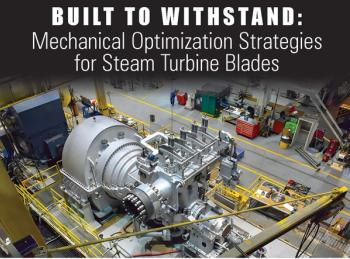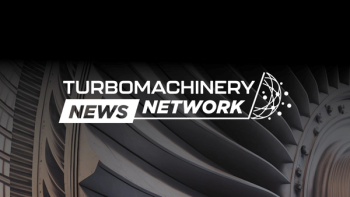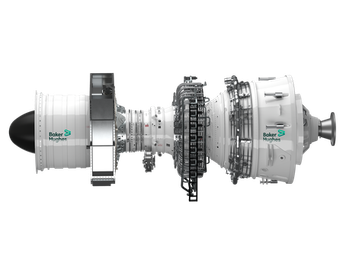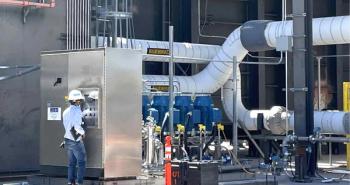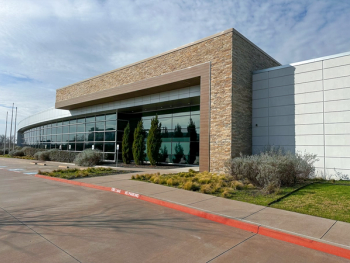
- November/December 2025
- Volume 66
- Issue 7
Steam Turbine Optimization for Mechanical Drive Applications – Part 2
Key Takeaways
- Mechanical design in steam turbines involves stress analysis, vibrations, aerodynamics, and material science to optimize performance and durability.
- Mean stress impacts material response over time, influenced by steam bending, centrifugal forces, and blade geometry.
Mechanical design decisions—ranging from stress management to natural frequency tuning—play a critical role in the reliability of steam turbines across demanding mechanical drive applications.
Steam turbines used in mechanical drive applications must operate across a wide range of conditions, often in challenging environments and under varying loads. As outlined in Part 1 of this series, aerodynamic design plays a critical role in optimizing turbine performance—focusing on blade shapes, flow path efficiency, and velocity profiles to ensure that each turbine stage operates as close as possible to its ideal conditions. However, aerodynamic efficiency alone is not sufficient. The mechanical integrity of each component must also be considered, particularly in applications where operational flexibility, longevity, and reliability are essential.
In Part 2, the focus shifts from aerodynamic and flow path optimization to the mechanical design challenges that influence turbine durability and long-term performance. This installment examines the complex interplay between blade geometry, stress distribution, material properties, and dynamic forces such as oscillatory stimulus and harmonic excitation. The article outlines methods to manage both mean and alternating stress, highlighting how design trade-offs—between mass, shape, frequency response, and damping—can significantly affect blade reliability. By understanding these relationships, engineers can better balance performance targets with mechanical resilience, ensuring optimized steam turbine operation across a wide range of mechanical drive applications.
MECHANICAL OPTIMIZATION CONSIDERATIONS
Various disciplines contribute to steam turbine mechanical design and optimization, including stress analysis, vibrations, aerodynamics, and material science. Impacts to aerodynamic optimization should be limited, and design changes should mechanically optimize the stage without jeopardizing performance. This section explores various options for improving blade reliability, along with several factors to be considered when evaluating blade stresses. The primary aerodynamic influences that contribute to blade stress are mean stress and alternating stress.
MEAN STRESS
Mean stress is the average of the maximum and minimum stresses experienced during a cycle. It accounts for the steam bending stresses from the aerodynamic forces, as well as the centrifugal and shear forces, and it significantly impacts how materials respond to stress over time.
Steam Bending Stress
Depending on the operating conditions, the airfoil will experience a combination of axial and tangential steam forces (Figure 1). The primary factors driving these forces are based on the general power being produced by that stage, along with any pressure reaction. Variations of blade designs will have different blade loading based on several factors, including the airfoil section shape, reaction levels, and operating conditions.
For airfoils with a relatively constant cross section, the bending force distribution is fairly uniform. Taper twisted airfoils will have non-uniform loading at various radial locations. Large taper twisted airfoils are typically designed with very low to no reaction at the hub, moderate reaction at midspan, and higher reaction near the tip, which contributes to the non-uniform loading (Figure 2).
For a stage with a large force causing bending stress about either the strong or weak axis, modifications to decrease the distance to this outer-most fiber can be made. Scaling the airfoil sections such that the pitch to chord ratio of the optimized design is maintained is the preferred method to reduce bending stresses. This does not increase the profile losses. Any increase in total pressure losses is then limited to the increase in secondary losses due to the change in the aspect ratio.
Centrifugal Stress
Centrifugal stresses create some of the highest blade stresses in steam turbine applications. Keeping the mass of the airfoil low is important in reducing centrifugal forces. However, the design must also handle the bending forces, so it is important to find the balance when modifying any geometry to a stage being evaluated. Changing the mass of the airfoil will also impact the blade natural frequencies.
Angular velocity has a large influence on the overall centrifugal stress. The speed of the steam turbine is often set by the driven equipment, and there may not be a gear box to adjust the speed. If the application has the option to reduce the operating speed, the angular velocity can be reduced, which in turn, reduces the centrifugal stress. However, a reduction in speed has performance implications that require the stage to be located further radially outward to operate at an optimum velocity ratio.
Alternatively, reducing the radial distance with respect to the center of gravity will reduce centrifugal stress. However, this also has a performance impact that requires running the turbine faster, which increases the rotational velocity component. Again, the speed is normally set by the driven equipment. The resulting radial position is based on the optimum velocity ratio and stage reaction levels.
Two other areas that can be adjusted to reduce stress are the mass and cross-sectional areas. One option is to reduce the mass of the blade by scaling down the airfoil sections above the high stress section. Scaling down the airfoil sections reduces the mass; however, it also reduces the cross-sectional area, which can lead to increases in both centrifugal and steam bending stresses. Changing to a lower density material will also reduce the mass, but operating temperatures must be considered to ensure the material has adequate tensile strength.
Finally, increasing the scale of the airfoil sections, while keeping the integrity of profile shape throughout, will increase the cross-sectional area. However, this also leads to an increase in the mass of the blade. This will provide improvements to the steam bending stress and should be considered in parallel. During initial design of new airfoils, each section is evaluated for the combinations of centrifugal and steam bending stress to increase lower section scales, while keeping the outermost radial sections smaller to limit the added mass above that section. This is typically a tradeoff between the mechanical design and the aerodynamics that can result in several iterations during the design process to resolve this needed balance.
Stress Concentration
The design of the buckets incorporates various geometric differences, such as shoulders, fillets, and grooves. These geometric differences create an increase in stress called a stress concentration. The presence of a sharp notch disrupts the normal flow of stress through the airfoil, causing the stresses to become concentrated. Design changes in geometry are typically blended with a fillet radius. The stress concentration in the fillet is influenced considerably by a notch factor as well as the notch sensitivity.
For a given application, the stress concentration may be improved by using a larger fillet radius to improve the flow of stress through the blade. When considering the base of vane interface to the root platform, a larger radius may be applied; however, it is important to consider the impact this will have to the aerodynamic secondary losses as well as the effective area.
Surface Roughness
Surface roughness can influence the fatigue limit of the turbine blade. This impact is a function of the manufactured surface finish and the ultimate tensile strength of the material. For both performance and stress, a better surface finish is desirable and provides both lower profile losses and reduced stress risers. Surface roughness can also be impacted by the operating environment of the stage that can degrade the surface over time, such as moisture erosion, solid particle erosion, and corrosion.
When evaluating an airfoil for mechanical optimization, it is important to account for how the stage will be operating and consider the environmental influences the stage may experience during long-term operation. In operating environments that could result in water droplet erosion, for example, it may be required to apply some form of protection to the leading edge to limit or reduce the rate of erosion. Additional methods to reduce erosion include reducing the trailing edge thickness of the upstream nozzle to reduce the droplet size, increasing the spacing between the nozzle trailing edge and the bucket leading edge, and/or designing a moisture removal system to reduce the amount of moisture passing through the main flow path.
ALTERNATING STRESS
All steam turbines are subject to alternating stress, which can take two forms - forcing (amplified) and attenuation (reducing). The forcing form consists of the steam bending forces described earlier, which are applied as an oscillatory stimulus. The same mechanical optimization philosophy applies for improvements from steam bending forces.
Oscillatory Stimulus
Oscillatory stimulus can be attributed to flow non-uniformity imposed by wakes from the upstream nozzles, backward reflection from downstream nozzles, inlet circumferential pressure variation, and discharge circumferential pressure variation. The primary forcing functions that have the greatest impact to alternating stress are nozzle stimulus and harmonic stimulus.
Nozzle Stimulus
Nozzle stimulus is caused by circumferential, periodic non-uniformity in the nozzle exit flow field that includes the core passage flow and periodic wakes. The wakes are low momentum flow. The flow velocity in the wake is reduced in comparison to the core passage flow. The velocity vector angle is also different. This changes the bucket surface pressure distribution as the low momentum wake fluid passes through the passage. Both the tangential and axial forces on the bucket change with the variation in the blade surface pressure distribution. The momentum deficit in the wake flow is the greatest in the nozzle trailing edge plane. This deficit reduces with axial distance due to mixing with the passage flow. Figure 3 shows the velocity contours depicting the nozzle wake.
In most applications, flow velocity is determined by the stage design and operating conditions of the turbine. This leaves the gap ratio as the primary parameter that can be adjusted to help reduce the alternating stresses. The gap ratio is normally optimized to provide the least aerodynamic impact while minimizing the stimulus.
Typically, not much can be done to reduce the nozzle wake and shock stresses since this is a function of the aerodynamic design. However, it is important to avoid increasing the resulting attenuated stress. Nozzle stimulus reduction can include changes such as the number of blades per group, changing the number of nozzles, and/or increasing the arc of admission as close to full admission as possible.
Harmonic Stimulus
The harmonic stimulus is a sine wave of pulses over one revolution. Some examples that produce harmonic stimulus include, nozzle passing frequency, non-uniform vane spacing, joint leakage, extractions, inductions, seal reinjection, struts, and piping obstructions. These are considered high frequency excitations and are important when evaluating the blade natural frequencies to ensure they do not coincide to excite the mode shape of the blade.
Other variations in geometry can produce pressure variations on the bucket. Any downstream obstructions can impose backward traveling wakes, such as pressure variations in exhaust diffusers or hoods that have non-symmetrical flow. This can lead to circumferential pressure distortion that results in unsteady excitation forces on the last stage.
If the frequencies of excitation coincide with the blade natural frequency, design changes can be made to either eliminate the source of excitation or change the blade natural frequencies. When a nozzle passing frequency coincides with a fundamental blade frequency, changes to the number of nozzles or changing the number of rotating blades to avoid this interference within the operating speed range can be applied. When looking at any blade natural frequencies, it is important to identify the natural frequencies that can have an aerodynamic source of excitation, and to account for the associated alternating stress.
Blade Natural Frequencies
For an optimized design that cannot avoid an excitation source, investigations to either change some features to dampen the response of the excitation or change the blade natural frequency are considered. Blade natural frequencies can be increased to avoid this interference by stiffening the blade with either a partially or fully locked system at the tip of the blade assembly, at the mid span, or at both locations. A fully locked system will provide low but consistent damping; however, it provides an increase in the blade natural frequencies. With a fully locked system, the interfacing surfaces are designed to remain in contact throughout the entire speed range. In a partially locked system, the surfaces will experience microslip which provides a significant increase in frictional damping and a moderate change in blade natural frequency. The force between the contact surfaces influences the amount of change for both damping and frequency.
In many steam turbine blade designs, centrifugal forces and blade untwist influence the contact force between the contacting surfaces. For mechanical drive steam turbines with a wide speed range, the blade natural frequencies and amount of damping will change when operating at low speed versus higher speeds. Additionally, the frictional behavior of microslip can lead to wear on the contacting surfaces over time, further influencing the resulting blade natural frequency and damping for a given operating speed. In a macroslip design, the frequencies will remain relatively unaffected; however, they provide a large amount of frictional damping. If adding a macroslip design feature to any airfoil, it is important to position and align it on the blade where the mode shape has the highest motion to effectively dissipate energy from the response.
Modal Damping
Damping can be divided into three primary categories: material damping, mechanical damping, and aerodynamic effects. Material damping is not dependent on the mode shape, but can be influenced by the stress and operating temperature. Aerodynamic effects can provide a significant but variable amount of damping, depending on the operating conditions. When evaluating the range of operating conditions, it is important to avoid any flow separation as aerodynamic damping can be driven negative by any flow separation. If negative damping exceeds positive mechanical damping, blade flutter can occur.
Mechanical damping can be added by adding design features that introduce frictional damping and are placed at a mode shape location that has high amplitude. The amount of mechanical damping is dependent upon the mode shape and the direction of the mechanism used to provide the damping.
The airfoil attachment to the disk can provide root damping. Effective damping is based on the contact lands orientation relative to the mode shape direction and the ratio of the root height to blade height. Root contact lands that are parallel to the mode shape direction provide the most damping. The amount of effective damping is adjusted based upon the root height. The taller the blade height relative to the root height, the lower the effective damping.
Moisture Environment
In condensing steam turbines, the steam quality is the measure of liquids present in the steam, often presented as a percentage of moisture. The initial formation of liquids at 1-to-4 percent is called the phase transition zone (PTZ). At PTZ, steam contaminants begin dropping out of the steam, impacting the endurance limit of the blade material. In most steam turbine applications, the steam chemistry is monitored and treated to maintain steam purity at acceptable levels. Even when monitored and treated, the steam will have trace amounts of contaminants. These contaminants can reduce the endurance limit of the blade material and also lead to solid particle erosion, stress corrosion, or reduced performance as deposits collect in the flow path. Designers need to account for a reduction in the material endurance limit of the stages operating in the PTZ environment and consider the potential deposition of contaminants. Coatings or upgraded materials are often applied to reduce PTZ impact. Blade designs can also be influenced when deposits interfere with effective damping of wires or pins. This can limit the amount of effective damping, further locking up the system and changing blade natural frequencies.
For a given blade experiencing water droplet erosion, the initial rate of erosion will be very high, but after several hundred hours of operation, the rate of erosion will decay substantially. The rougher surface on the leading edge created by the erosion assists in breaking up water droplets, helping to reduce this rate. When designing a stage for this environment, several changes can be made. The most common approach is to provide erosion protection to the leading edge of the blade. This protection provides a hardened surface at the high rotating velocity sections of the leading edge that can withstand the expected impact of the water droplets. Additional changes can include reducing the nozzle trailing edge thickness to reduce the water droplet size, and increasing the spacing between the stationary nozzle exit and rotating bucket inlet.
Overall, turbine designs should include a moisture-catching system and a method to evacuate this liquid between stages to prevent liquids from passing through the nozzle and into the rotating blade. Ultimately, a stage operating with a high moisture percentage affects the surface finish of the airfoil. The resulting surface roughness creates concentrated stresses on the eroded sections and causes a reduction in allowable stresses. This is accounted for in the reduction of the endurance limit by adjusting the surface finish of the blade. For condensing steam turbines, a combination of a PTZ and moisture is always present. It is important to consider the aerodynamic impact of design changes on the performance of the stage.
MODIFIED GOODMAN FACTOR
The Goodman Factor is the material design allowable strength divided by the total alternating stress. The Modified Goodman Factor defines the actual mean and alternating stress versus the allowable stresses. Many of the details described earlier will influence either the alternating stress or mean stress values. Design changes can increase or reduce the alternating stresses and also the allowable alternating stress.
The Modified Goodman Factor is based on three primary limits:
- Material fatigue limit – defined by the material without material endurance limit correction factors
- Goodman failure limit – includes the material endurance limit correction factors, reducing the allowable alternating stress limits
- Design limit – provides additional margin to account for uncertainty in correction factors, alternating stress, and mean stress predictions
The allowable alternating stress consists of the adjusted material endurance limit, the ultimate tensile strength at the operating temperature, and the mean stress. The adjusted material endurance limit comprises the following fatigue strength reduction factors:
- Stress concentration factor – accounts for stress risers in a fillet radius where large geometric changes take place
- Surface finish factor – accounts for the manufactured surface finish which can be adjusted based on operating conditions
- Size factor – compensates for the difference between fatigue data test pieces and actual blade sizes
- Reliability factor – provides margin to the design limits based on uncertainty in parameters used to predict the alternating stresses and allowable stress limits
- Temperature factor – corrects for the operating temperature
- Environmental factors – account for harsh environment operating conditions such as PTZ exposure to steam contaminants
The total applied alternating stress is more complex when it comes to blade dynamics. The steam forces are not continuous, and they vary around the circumference of a stage. These variations can be attributed to nozzle wakes that occur at nozzle passing frequency harmonics, downstream nozzle backward reflections, pressure variations on control stages, and other circumferential pressure variations at the discharge. All of the alternating forces produce an alternating stress that is evaluated at multiple points on the rotating blade to determine the highest stress point. These forces are evaluated to determine which may coincide with exciting a blade natural frequency. The design of an airfoil considers each frequency of concern relative to the stimulus produced by any of the forces that can excite the mode shape being considered. Each of these excitation components can attribute to the total alternating stress.
CONCLUSION
Axial flow steam turbines operate in a wide range of conditions across a variety of mechanical drive applications. Understanding the influence that the aerodynamics and mechanical designs have on each other is critical in optimizing the designs. This article describes the optimization methods needed to evaluate each unique application, using advanced analysis tools to balance the aerodynamics and mechanical design concerns. This ensures steam turbines can be designed to not only operate at high efficiency levels, but are able to withstand the wide range of operating conditions required for mechanical drive applications.
About the Authors
Adam Neil, Director, Global Technical Services, Ebara Elliott Energy; Nikhil Rao, Sr. Aerodynamics Engineer, Ebara Elliott Energy; Paul Smith, Sr. Engineer, Research & Development, Ebara Elliott Energy
Articles in this issue
Newsletter
Power your knowledge with the latest in turbine technology, engineering advances, and energy solutions—subscribe to Turbomachinery International today.

